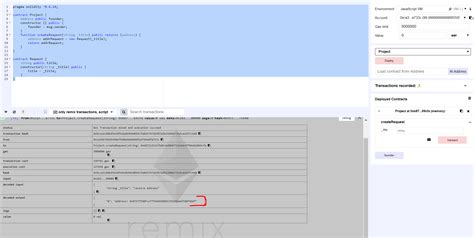Decoding the Ethereum transaction very huge raw

While the bloc chain continues to analyze to extract certain information, you can find unprecedented transactions that are too big for their processing systems or opportunities. In this article, we will explore how to decode on very huge raw Ethereum transactions.
Why are big transactions a problem?
When analyzing large transactions, you can face several challenges:
* Memory limitations : Unprofessional transactions data are often stored in a compressed format, which can lead to memory problems in your system.
* power construction limit : some blockchains have limited computer resources, which makes it difficult to process large amounts of data.
Decoding large raw transactions
To solve these problems, you will need to use specialized tools or libraries that can decode and effectively analyze the data of unprocessed transactions. Here are some approaches:
1. Ethers.js' Library
"Ethers." An option for analysis of the Ethereum transaction in Javascript is a popular. Provides an effective way to decod large unprocessed transactions using its optimized 'decodewtrasaction' function.
Javascript
Const ether = demand ('ether');
// Analyze a block chain to get a transaction information
Async paetransactidata () {{)
Const Tx = Waiting EtherS.wallet.Gettransation ("0x ..."); // Replace yourself with hash transactions
// decipher and analyzes unprecedented transaction data
Consta decodewtransation = new ethers.decoderrawtransation (TX);
Const decodeedtx = awaits decodewtransation.decode ();
Return decodeedtx;
Iche
PLANSTSACTIONATA (). then (decodeedtx => console.log (decodeedtx));
2.
TheTruffle-Eethereumlibrary offers a set of tools to work with Ethereum smart contracts and transactions. Includes the optimized 'decodewtrasaction' function that can withstand major data.
Javascript
Const {Ethers} = demand ('truffle-ethhereum');
// Analyze a block chain to get a transaction information
Async paetransactidata () {{)
Const Tx = Waiting EtherS.wallet.Gettransation ("0x ..."); // Replace yourself with hash transactions
Return a new promise ((rolve, rejection) => {
tx.rawtransation.then ((rawtx) => {
Const decodewtransation = new ethers.decoderrawtransation (RAWTX);
Const decodeedtx = decodewtransation.decode ();
resolution (decodeedtx);
}). To capture ((error) => {
refuse (error);
});
});
Iche
PLANSTSACTIONATA (). then (decodeedtx => console.log (decodeedtx));
3.
'Solided-Ethers' library is a popular option for working with Smart Treaties Ethereum in Javascript. Includes the optimized class 'Decoderrawtransation' that can submit big data.
Javascript
Const {Solidy} = demand ('firmness');
// Analyze a block chain to get a transaction information
Async paetransactidata () {{)
const tx = alea solid.getabi ("0x ..."); // Replace yourself with hash transactions
Return a new promise ((rolve, rejection) => {
Const decoderrawtransation = new dot.
Const decodeedtx = decoderrawtransation.decode ();
resolution (decodeedtx);
});
Iche
PLANSTSACTIONATA (). then (decodeedtx => console.log (decodeedtx));
Select the right approach
Deciding which approach to use consider the following factors:
* Introduction requirements : If you need to process large amounts of data,ethers.jso'truffelo-ethereum can be a better option.
* Simplicity of use : PALYTY-ETHERS 'is often considered easier for developers who are familiar with firmness.
* Licens and support :Ethers.jsis an open source according to the MIT license, while the dried truffle-esethereum and` Soloty-Ethers “under allowed licenses of the Ethereum Foundation.
